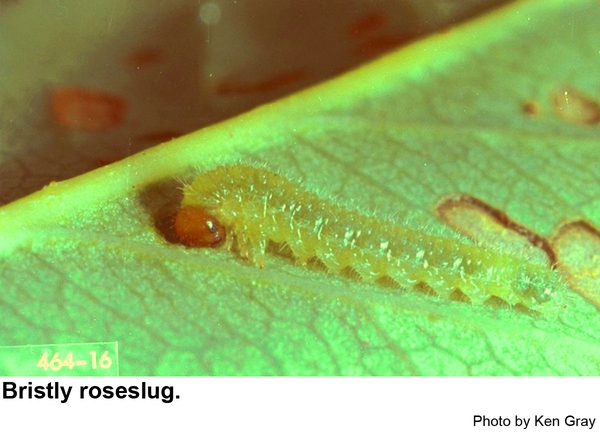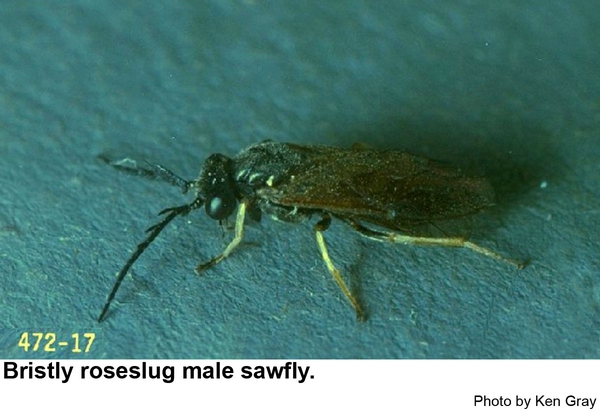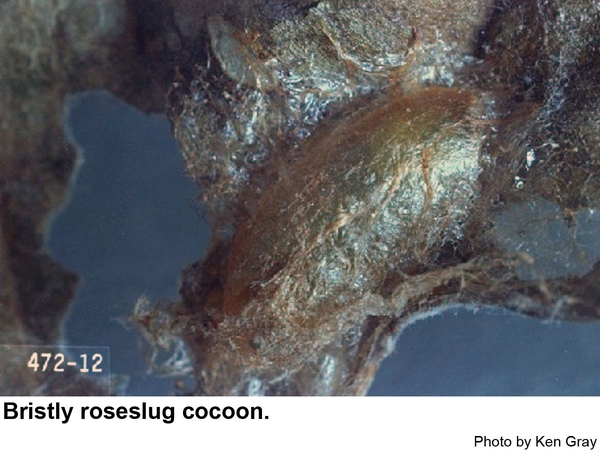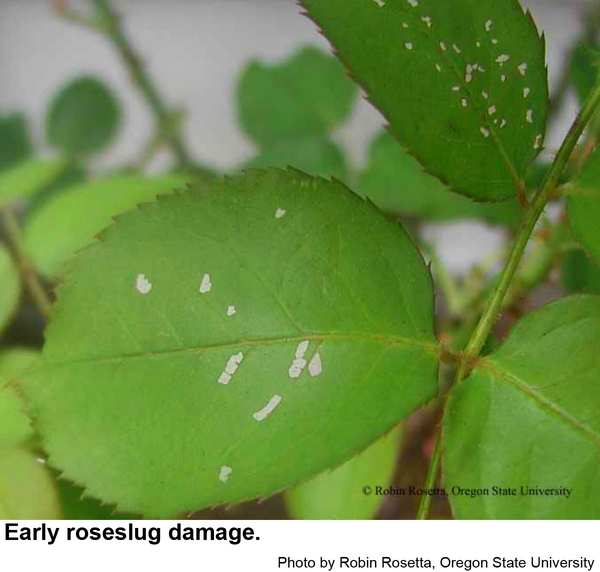Description and Biology
The accidentally introduced bristly roseslug, Cladius difformis, is called “bristly” because the larvae have bristly-like setae that protrude along the sides and back. These caterpillars are very small, and the setae are not noticeable without magnification. Adult bristly roseslug sawflies are black, stout, wasp-like insects about ½ inch long. Female antennae are slender and male antennae are pectinate (somewhat comb-like at the base). Tiny (about 1/32 inch), more or less oval eggs are inserted in the upper surface of the petiole of the leaf in rows of three or more. Larvae soon hatch and resemble slender slugs. Bristly roseslugs feed on the underside of rose leaves causing leaves to appear skeletonized. Older larvae chew large holes and also notch the leaf margins. The larvae are about ½ inch up to ¾ inch long when full-grown and yellow-green with an orange head. When fully grown, they spin a cocoon on the host plant or eventually fall on the soil surface to spin a cocoon and pupate. Bristly roseslugs overwinter as pupae in earthen cells. Unlike the common or American roseslug sawfly (Endelomyia aethiops), which has only one generation per year or the less common curled roseslug (Allantus cinctus), which has two generations per year, the bristly roseslug has multiple generations each year.
Host Plants
Wild and cultivated roses and spirea are hosts listed for the bristly roseslug. Young caterpillars feed as leaf skeletonizers on the lower leaf surfaces. The epidermis on the upper leaf surface becomes a white spot that eventually drops out, leaving a hole. Older bristly roseslugs feed between the main veins and chew holes in leaves. Because it is a larger insect than the other two roseslugs and because it has multiple generations per year, the bristly roseslug can be quire damaging.
Residential Recommendations
Look for transparent spots on rose leaves caused by the young bristly roseslugs on the under surface. Small infestations can be removed by hand and dropped into soapy water. Spraying infested roses with a garden hose should dislodge and injure sawfly larvae. Most insecticides labeled for residential landscape use are effective except those based on the bacterium Bacillus thuringiensis (Dipel or Thuricide). It is not a good idea to spray open flowers because bees and other pollinators will be killed. Try to direct any spray upward to the lower leaf surface where the bristly roseslugs are feeding.
Other Resources
- Bristly Roseslugs Continue to Cause Damage. Boggs, J. 2016. Bug Bytes, The Ohio State University Extension.
- Rose Sawflies: Out With a Vengeance! Cloyd, R. 2021 (updated). Extension Entomology, Kansas State University.
- Rose sawflies (roseslugs)—Allantus cinctus, Cladius difformis, and Endelomyia aethiops. Anonymous. No Date. Pests in Gardens and Landscapes, UC IPM, Statewide IPM Program.
- Roseslug. Rosetta, R. L. (2016 latest). Extension Nursery IPM, Dept. of Horticulture, Oregon State University.
- The Rose Slugs. Chittenden, F. H. 1908. Circular No. 105. United States Department of Agriculture, Bureau of Entomology.
- NC State Extension Plant Pathology Publications
- NC State Horticultural Science Publications
- North Carolina Agricultural Chemicals Manual
For assistance with a specific problem, contact your local Cooperative Extension center.
This factsheet has not been peer reviewed.
Publication date: May 22, 2021
Recommendations for the use of agricultural chemicals are included in this publication as a convenience to the reader. The use of brand names and any mention or listing of commercial products or services in this publication does not imply endorsement by NC State University or N.C. A&T State University nor discrimination against similar products or services not mentioned. Individuals who use agricultural chemicals are responsible for ensuring that the intended use complies with current regulations and conforms to the product label. Be sure to obtain current information about usage regulations and examine a current product label before applying any chemical. For assistance, contact your local N.C. Cooperative Extension county center.
N.C. Cooperative Extension prohibits discrimination and harassment regardless of age, color, disability, family and marital status, gender identity, national origin, political beliefs, race, religion, sex (including pregnancy), sexual orientation and veteran status.




